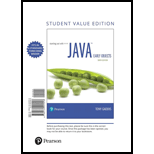
Course Grades
In a course, a teacher gives the following tests and assignments:
- A lab activity that is observed by the teacher and assigned a numeric score.
- A pass/fail exam that has 10 questions. The minimum passing score is 70.
- An essay that is assigned a numeric score.
- A final exam that has 50 questions.
Write a class named CourseGrades. The class should have a GradedActivity array named grades as a field. The array should have four elements, one for each of the assignments previously described. The class should have the following methods:
| setLab: | This method should accept a GradedActivity object as its argument. This object should already hold the student’s score for the lab activity. Element 0 of the grades field should reference this object. |
| setPassFai1 Exam: | This method should accept a PassFailExam object as its argument. This object should already hold the student’s score for the pass/fail exam. Element 1 of the grades field should reference this object. |
| setEssay: | This method should accept an Essay object as its argument. (See |
| setFinal Exam: | This method should accept a FinalExam object as its argument. This object should already hold the student’s score for the final exam. Element 3 of the grades field should reference this object. |
| toString: | This method should return a string that contains the numeric scores and grades for each element in the grades array. |
Demonstrate the class in a program.
Want to see the full answer?
Check out a sample textbook solution
Chapter 9 Solutions
Starting Out with Java: Early Objects, Student Value Edition (6th Edition)
Additional Engineering Textbook Solutions
INTERNATIONAL EDITION---Engineering Mechanics: Statics, 14th edition (SI unit)
Web Development and Design Foundations with HTML5 (8th Edition)
Database Concepts (8th Edition)
Starting Out With Visual Basic (8th Edition)
Java: An Introduction to Problem Solving and Programming (8th Edition)
Starting Out with C++ from Control Structures to Objects (9th Edition)
- Please solve and answer the questions correctly please. Thank you!!arrow_forwardConsidering the TM example of binary sum ( see attached)do the step-by-step of execution for the binary numbers 1101 and 11. Feel free to use the Formal Language Editor Tool to execute it; Write it down the current state of the tape (including the head position) and indicate the current state of the TM at each step.arrow_forwardI need help on inculding additonal code where I can can do the opposite code of MatLab, where the function of t that I enter becomes the result of F(t), in other words, turning the time-domain f(t) into the frequency-domain function F(s):arrow_forward
 EBK JAVA PROGRAMMINGComputer ScienceISBN:9781337671385Author:FARRELLPublisher:CENGAGE LEARNING - CONSIGNMENT
EBK JAVA PROGRAMMINGComputer ScienceISBN:9781337671385Author:FARRELLPublisher:CENGAGE LEARNING - CONSIGNMENT Microsoft Visual C#Computer ScienceISBN:9781337102100Author:Joyce, Farrell.Publisher:Cengage Learning,
Microsoft Visual C#Computer ScienceISBN:9781337102100Author:Joyce, Farrell.Publisher:Cengage Learning, Programming with Microsoft Visual Basic 2017Computer ScienceISBN:9781337102124Author:Diane ZakPublisher:Cengage Learning
Programming with Microsoft Visual Basic 2017Computer ScienceISBN:9781337102124Author:Diane ZakPublisher:Cengage Learning- Programming Logic & Design ComprehensiveComputer ScienceISBN:9781337669405Author:FARRELLPublisher:Cengage
 EBK JAVA PROGRAMMINGComputer ScienceISBN:9781305480537Author:FARRELLPublisher:CENGAGE LEARNING - CONSIGNMENT
EBK JAVA PROGRAMMINGComputer ScienceISBN:9781305480537Author:FARRELLPublisher:CENGAGE LEARNING - CONSIGNMENT C++ for Engineers and ScientistsComputer ScienceISBN:9781133187844Author:Bronson, Gary J.Publisher:Course Technology Ptr
C++ for Engineers and ScientistsComputer ScienceISBN:9781133187844Author:Bronson, Gary J.Publisher:Course Technology Ptr





